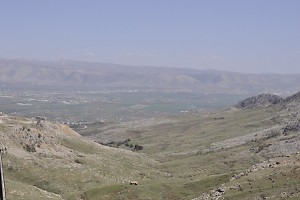Coele Syria
Q1123749Coele Syria (Greek Κοίλη Συρία): ancient geographical expression to describe several territories in the Near East.

At first sight, “Coele Syria” appears to be Greek for the “hollow” part of Syria, which may refer to the Bekaa valley. This part of modern Lebanon fits the description quite well, because it is indeed a hollow valley between the Lebanon and Anti-Lebanon mountain ranges. This is the way the geographer Strabo, uses the expression,note although he is aware of other interpretations.noteUsually, the expression was used to refer to a bigger area, some writers expanding it from the Bekaa to the south, along the river Jordan, others to the north, in the direction of the Euphrates.
It is also possible that coele renders the Aramaic word kul, “all”. This theory leaves unexplained why the ancients did not call Syria simply “Syria” and used the expression “all of Syria” to describe what was just a part of it. Nor does it explain why they did not use a Greek word.
However this may be, the expression was used to describe the southwestern part of the Levant in a very specific context. After the death of Alexander the Great, his empire was divided between his generals, who immediately started several wars. In 301 BCE, the final battle was fought at Ipsus (in modern Turkey) between Antigonus I Monopthalmus and a coalition of others, which included Seleucus I Nicator. The coalition was victorious, divided the spoils; and awarded most Asian possessions to Seleucus. However, before he could establish control in the area now known as Lebanon and Israel, this part of the Near East was seized by Ptolemy I Soter, who had established himself as king of Egypt. Because Seleucus once had received help from Ptolemy, Seleucus found it beneath his dignity to conquer what was rightfully his, but he did not abandon his claim.
The occupied territories – the Bekaa valley, the Jordan valley, and the ports along the Mediterranean shore up to Aradus – were called “Coele Syria” and were contested in several wars between the Ptolemies (who fortified towns like Scythopolis and Philadelphia to control the Jordan valley and built the sanctuary at Baalbek) and the Seleucids, who in the end conquered the area. Five wars are relevant:
- The Carian War (280-279), in which Ptolemy’s son Ptolemy II Philadelphus captured Damascus.
- The First Syrian War (274-272), in which a general of Seleucus’ son Antiochus I Soter reconquered Damascus.
- The Laodicean or Third Syrian War (246-241), in which Ptolemy III Euergetes expanded Ptolemaic control of the Syrian shore up to Seleucia.
- The Fourth Syrian War (220-217), in which the Seleucid king Antiochus III the Great reconquered Seleucia.
- The Fifth Syrian War (202-195), in which Antiochus III the Great took all Asian possessions from the Ptolemies.
Retrospectively, the expression could also be used to indicate the satrapy ’Abar nahara, “across the river” (Euphrates) in the former Achaemenid Empire.note The Jewish historian Flavius Josephus used the expression to indicated the Decapolis, which had indeed been the focus of much Ptolemaic building activity, which was meant to defend Coele Syria.note
The Graeco-Roman author Arrian distinguishes between on the one hand Palaestina and Phoenicia and on the other hand Coele Syria, which now is more or less identical to the land between the Lebanon/Amanus range and the Euphrates.note This same distinction was also made when the Roman emperor Septimius Severus divided the province of Syria in two smaller provinces.